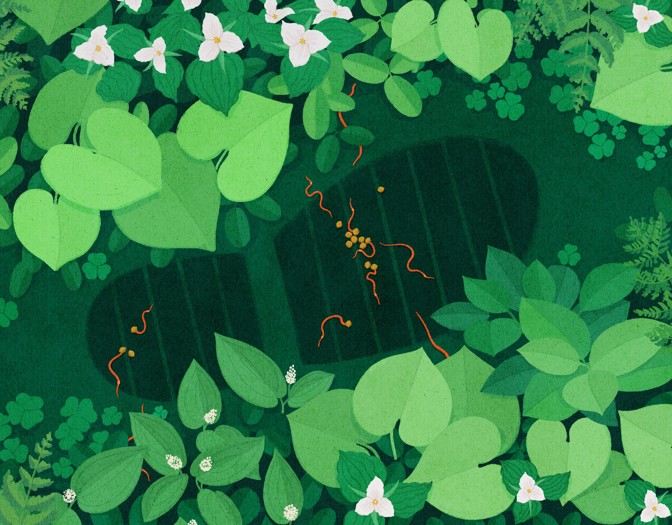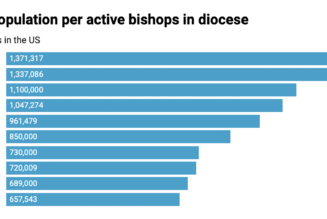On a sweltering July day, I follow Annise Dobson down an overgrown path into the heart of Seton Falls Park. It’s a splotch of unruly forest, surrounded by the clamoring streets and cramped rowhouses of the Bronx. Broken glass, food wrappers, and condoms litter the ground. But Dobson, bounding ahead in khaki hiking pants with her blond ponytail swinging, appears unfazed. As I quickly learn, neither trash nor oppressive humidity nor ecological catastrophe can dampen her ample enthusiasm.
At the bottom of the hill, Dobson veers off the trail and stops in a shady clearing. This seems like a promising spot. She kicks away the dead oak leaves and tosses a square frame made of PVC pipe onto the damp earth. Then she unscrews a milk jug. It holds a pale yellow slurry of mustard powder and water that’s completely benign—unless you’re a worm.
Seconds after Dobson empties the contents inside the frame, the soil wriggles to life.
“Holy smokes!” she says, as a dozen worms come squirming out of the soil—their brown, wet skin burning with irritation. “Disgusting.” I have to agree. There is something unnerving about their slithering, serpentine style; instead of inching along like garden worms, they snap their bodies like angry rattlesnakes. But the problem with these worms isn’t their mode of locomotion. It’s the fact that they’re here at all.
Until about 10,000 years ago, a vast ice sheet covered the northern third of the North American continent. Its belly rose over what is now Hudson Bay, and its toes dangled down into Iowa and Ohio. Scientists think it killed off the earthworms that may have inhabited the area before the last glaciation. And worms—with their limited powers of dispersal—weren’t able to recolonize on their own.
For someone like me, who grew up in the Midwest seeing earthworms stranded on the sidewalk after every rain, this was a shocking revelation. With the exception of a few native species that live in rotting logs and around wetlands, there are not supposed to be any earthworms east of the Great Plains and north of the Mason-Dixon Line.
But there are, thanks to humans. We’ve been moving worms for centuries, in dirt used for ship ballast, in horticultural plants, in mulch. Worms from South America now tunnel through the global tropics. And European earthworms live on every continent except Antarctica. Dobson, a forest ecologist at Yale University, calls it “global worming.”
But of all the earthworms people have shuttled around the world, the ones Dobson shows me at Seton Falls have scientists most concerned. Originally from Korea and Japan, they are known as jumping worms, snake worms, or crazy worms. And they have the potential to remake the once wormless forests of North America.
The perils of an earthworm invasion are hard to grasp if you’ve been raised to believe that earthworms are good. “They seem so symbolic of a healthy ecosystem,” Dobson says. For their stellar reputation, they can thank none other than Charles Darwin. In addition to developing the theory of evolution, Darwin studied earthworms for 40 years at his home in England.
With characteristic curiosity and rigor, the naturalist conducted all manner of earthworm experiments: He observed their reaction to the sound of the bassoon (none) and to the vibrations of a C note played on the piano (panic). He watched how they pulled leaves into their burrows, and tested their problem-solving skills by offering them small triangles of paper instead (most figured out how to drag them by a corner). Darwin also measured how quickly worms covered up a large paving stone in his garden with their castings. He estimated that they could move at least 10 tons of soil per acre per year.
Read: A creationist sues the Grand Canyon for religious discrimination
Dirty, slimy earthworms weren’t especially popular in Victorian England. But in 1881, shortly before his death, Darwin compiled his worm studies into a book called The Formation of Vegetable Mould through the Action of Worms with Observations on their Habits, in which he praised the humble critters. “It may be doubted whether there are many other animals which have played so important a part in the history of the world, as have these lowly organized creatures,” he rhapsodized. The book became a best seller, giving worms’ dingy public image a makeover in the process.
Gardeners now rejoice to find earthworms in their soil, and you can purchase a 1,000-pack of “Nature’s Wonder Workers” on Amazon for $45. There’s even an entire canon of worm-centric children’s literature, including Wiggling Worms at Work and Richard Scarry’s Best Lowly Worm Book Ever! But Peter Groffman, a soil ecologist at the City University of New York, says that while worms may do some good in your compost bin, they don’t deserve all the credit for your bumper crops and lush ornamentals. “The earthworms are in the soil because the soil is healthy,” he says. “They are not necessarily doing anything for it.”
And though they can be helpful for breaking up compacted soils and breaking down organic matter, worms can also cause trouble in agricultural fields. Their burrows create channels that allow nutrients and pesticides to leak from fields into nearby waterways, and carbon dioxide and nitrous oxide to escape into the atmosphere. In fact, a 2013 review of recent research found that worms likely increase greenhouse-gas emissions.
But Darwin wasn’t thinking about these things—and he certainly wasn’t thinking about the consequences of introducing worms into ecosystems that had evolved without them.
The mustard pour, which Dobson had done partly for my benefit and partly just to check in on the worm population, is over a few minutes after it begins. The worms—bothered but otherwise unscathed—have disappeared back into the forest floor. So Dobson and I head back to where we left her assistant, Mark, toiling among a jungle of knee-high poison ivy and Johnny jumpseed.
He’s searching for the pink flags that Dobson left here last year to mark a few dozen specimens of native plants. Her goal is to track them as they grow and reproduce to see if they show any potential of adapting to jumping worms. Mark, an undergraduate at the University of Connecticut, is doing his best. But it’s his first day on the job, and also, someone has deposited a filthy, yellowing mattress over much of Dobson’s research plot.
“That’s the beauty of working in urban systems,” Dobson jokes.
By now, it’s after 11 a.m. and the heat has grown unbearable, so Dobson suggests we decamp to a nearby McDonald’s. We pile into her silver Subaru Impreza, where the dashboard thermometer reads 38 degrees Celsius—100 degrees Fahrenheit. (Dobson and her car are both Canadian.) There is no gauge for the humidity, but it’s stifling.
Inside the restaurant, air conditioning and cold beverages revive our spirits. We settle into a booth, and I ask Dobson about North America’s first wave of earthworm invaders. Common species like Lumbricus terrestris, better known as the night crawler, arrived hundreds of years ago with European settlers, and have long been welcomed in gardens and farmland. In the 1980s, however, researchers began to find European worms in the forests of Minnesota and other northern states. One hypothesis is that people spread them when they throw away extra fishing bait next to lakes and streams.
The discovery alarmed scientists. In the absence of worms, North American hardwood forests develop a thick blanket of duff—a mille-feuille of slowly decomposing leaves deposited over the course of years, if not decades. That layer creates a home for insects, amphibians, birds, and native flowers. But when worms show up, they devour the litter within the space of a few years. All the nutrients that have been stored up over time are released in one giant burst, too quickly for most plants to capture. And without cover, the invertebrate population in the soil collapses.
Where millipedes and mites once proliferated, now there are only worms. “If you were to think about the soil food web as the African savanna, it’s like taking out all the animals and just putting in elephants—a ton of elephants,” Dobson says.
With their food and shelter gone, salamanders suffer and nesting birds find themselves dangerously exposed. Plants like trillium, lady’s slipper, and Canada mayflower vanish, too. This may be because the worms disrupt the networks of symbiotic fungus that many native plants depend on, or because worms directly consume the plants’ seeds. Or that native species, accustomed to spongy duff, are ill-prepared to root into the hard soil left behind when the worms have finished eating. It could be all of the above.
Perhaps most worryingly, early studies suggest that worms can sometimes halt the regeneration of trees. Josef Görres, a soil scientist at the University of Vermont, says he often struggles to find a single seedling in invaded portions of New England’s famous maple forests. His theory is that the worms take out all the understory plants, leaving nothing for deer to chew on but the young trees. And that could spell trouble for the region’s prized maple syrup industry. “In 100 years’ time, maybe it’s going to be Aunt Jemima,” he says. “That’s a real bad horror story for people in Vermont.”
Read: How to make a half-gallon of maple syrup in 20 easy steps
These sweeping powers are why earthworms are often called ecosystem engineers. And Dobson and her colleagues fear that jumping worms pose an even greater threat than their European predecessors. Jumping worms appear to have many of the same effects, except that they grow larger and exist in dense colonies, sometimes numbering more than a hundred individuals per square meter of ground. And while European worms range throughout the upper four to six feet of soil, jumping worms stick to the top six inches or so, churning it relentlessly into a loose sediment that Dobson likens to ground beef. (Others I talked to compared it to coffee grounds.)
The disturbed soil erodes easily, dries out quickly, and generally makes poor habitat for many plants. At McDonald’s, Mark pipes up to say that he noticed patches of it during his basic training at Fort Knox last year. While there, he cursed the lack of understory in which to take cover during tactical exercises.
Dobson explains that the worms act like a funnel, winnowing away the diversity of the forest. First, they take out the most sensitive native plants, leaving only hardy species like poison ivy and Virginia creeper. Then they prime the ground for invasives. Even more than their European relatives, jumping worms seem to reshape the forest from the ground up.
“Every single thing that they do is transformative,” Dobson says.
Until it moves, a jumping worm looks a lot like any other earthworm: long and thin, with rosy brown skin divided into bellows-like segments. Experts will tell you to look at the clitellum—the band that holds the reproductive organs of worms, which are hermaphrodites. In European worms, the smooth, pink clitellum is found closer to the middle of the body. On jumping worms, it’s milky white and sits near the head.
There are many species of jumping worms. The first arrived in the United States in California in the 1860s. Others have been in the Southeast for more than a century—long enough to earn colloquial names like the Alabama Jumper. (You can buy these online, too, but worm experts advise against spreading them.)
The three species that Dobson and others worry most about are newer arrivals, and likely hitchhiked on imported plants, where they caught the attention of groundskeepers. “The gardeners were out there saying, ‘I know these are earthworms; they are supposed to be good. But I swear, they are killing my plants,’” Dobson says.
An oft-repeated anecdote holds that jumping worms first appeared in Washington, D.C., among the cherry trees in 1912. By the 1940s, they were spotted at the Bronx Zoo, where one species was later raised to feed the resident platypuses. They have been in a few other New York parks for more than 50 years, which is why Dobson chose these forests to study their long-term ecological effects. For some reason, however, jumping worm populations have exploded in the last decade or so. And the worms are spreading even faster than Dobson imagined—including within city limits.
While in New York, I meet with Clara Pregitzer, a forester at the nonprofit Natural Areas Conservancy, who takes me on a tour of Forest Park in Queens. When I find her next to the statue of a somber soldier at the Richmond Hill War Memorial, she’s wearing tortoiseshell glasses, a loose white blouse, and dirty jeans cuffed above leather boots. We stroll up the tree-lined avenue, then turn off onto a shady path. “This is one of my favorite parks for showing off high-quality forest,” Pregitzer says.
Indeed, it’s a beautiful spot. Hundred-year-old oaks stretch their boughs across the wide trails and the understory is neither bare nor overgrown. (Pregitzer says the park has good “sight lines.”) The gently undulating landscape is a textbook example of the “knob and kettle” terrain left behind by retreating glaciers.
Earlier, over email, Pregitzer had warned that we might not find any jumping worms here. In 2013 and 2014, she led a survey of New York’s green spaces, tallying up the trees and understory plants and noting the distribution of jumping worms. She found heavy infestations in 12 percent of the plots she studied, though they may have been present in close to a third. Less than 5 percent of the plots at Forest Park showed signs of jumping worm activity.
But within ten minutes of walking, I spot the coffee-ground soil on the edge of the trail. Pregitzer decides to do her own version of the mustard pour: a dilute solution of dish soap. Within a few minutes, a parade of jumping worms emerges from the ground.“Oh, nasty,” says Pregitzer, scrunching up her nose.
We follow the worm soil away from the trail, 10 feet, 15 feet, 50 feet, into a shallow depression. There, we don’t need the dish soap. Brushing away the leaf litter reveals a dozen worms in an area the size of a dinner plate. Pregitzer picks up a six-inch-long monster with a stick. “Nasty,” she says again.
She is visibly unsettled by the discovery. “This is one of the best parks, and now that we are digging in a little bit and really looking for them, they’re everywhere,” she says, gazing around. “There have got to be, like, millions.” We keep walking for another hour or so, and, much to her dismay, find only one worm-free site—on a steep hill where the topsoil has washed away.
That’s a big change from a few years ago, and when I report the news to Annise Dobson, who is using Pregitzer’s survey data in her own work, she immediately decides to revisit the original study sites. A week after I get home, Dobson emails me to say that she’s finding worms everywhere. “I’m floored and honestly reeling from the extent of it,” she says. They are now in 64 percent of the plots across the city.

It’s not entirely clear how the jumping worms have spread. Conventional knowledge holds that they can’t cover much ground on their own—perhaps 30-odd feet in a year, although one researcher I talk to swears he’s seen a single worm move that far in an afternoon. Their cocoons, which are about the size of peppercorns, can be carried much farther in water, and scientists have noticed that invasions often march down hillsides and along waterways.
But experts suspect that the blame lies primarily with humans. It’s all too easy to unwittingly transport worms and cocoons in plants, mulch, and soil, in the treads of shoes and tires, or caked onto landscaping equipment.
Read: Is the insect apocalypse really upon us?
Perhaps we’ve been moving more earth in recent years, and carrying worms with it. A few major nurseries could be spreading them by accident. Or the worms may be benefiting from favorable conditions or some clever adaptation to their new environment. Whatever the reason, jumping worms have fanned out across the northern United States over the past few decades and continue to expand their territory. They were first identified in Rhode Island in 2015 and in Oregon in 2016, though they may have arrived earlier in both places.
As of late 2017, there had only been one sighting of jumping worms in Canada, but the country’s vast tracts of carbon-rich, worm-free boreal forest are already under siege by their European cousins. And scientists there know it’s only a matter of time before the jumping worms follow.
Bernie Williams remembers when she discovered jumping worms in Wisconsin. October 3, 2013, was “the day that ruined many of our lives,” says Williams, a worm expert at the state Department of Natural Resources.
She was leading a group of researchers and managers on a tour of the University of Wisconsin arboretum. Scientists already knew European worms had taken up residence there, and Williams led the visitors to a heavily invaded spot. But as soon as she saw the soil, she knew something was wrong. “These worms were everywhere,” she says.
Over the next three years, the jumping worms stormed across 25 acres of forest in the arboretum, effectively eradicating their European rivals. They have now been reported in 52 of Wisconsin’s 72 counties, Williams tells me, disproving predictions that the harsh winters would keep them at bay.
Many Madison residents know and loathe the worms, which can decimate flowers and vegetables. At a community garden near campus, I meet a man sifting compost through a screen as a precaution. “That usually catches ’em,” he says.
Sometimes, under the right conditions, the worms can reach “infestation” levels, and come pouring out of a house’s foundations “like Medusa’s head,” Williams says. “If you like invertebrates, you squeal with delight.” Homeowners, however, tend to be less thrilled, and in bad years, Williams spends her days fielding calls from disgruntled residents.
Dobson hears similar frustrations in heavily impacted parts of the East Coast. People are seeing changes in their gardens, in their local woods, even on their kids’ soccer fields (the worms can damage the roots of turf grasses). She’s watched people break down in tears and pick fights with their neighbors over who’s to blame for introducing the worms. “A lot of my time is taken up trying to comfort very upset people,” Dobson says.
Unfortunately, there isn’t much anyone can do once invasive earthworms get established. This becomes clear one day as I watch Brad Herrick and Marie Johnston crawl around for hours in Wisconsin’s mosquito-infested woods, plucking jumping worms from inside a series of two-foot-wide metal enclosures. Herrick and Johnston, both researchers at the UW arboretum, want to test one of the few promising weapons against jumping worms: a low-nitrogen fertilizer called Early Bird, commonly used on golf courses. To assess its effectiveness, they’ve been manually removing all the worms from each of 24 high-walled rings before adding back a known number of victims. (When I ask Herrick what they do with the evicted worms, he says, “We gently chuck them.”)
The problem is that the cocoons act like a seed bank. Mature worms lay them in the fall before they die, and the cocoons hatch throughout the spring and summer, providing a seemingly endless source of young worms. “It’s like a two-headed monster,” Herrick says.
Herrick and Johnston each claim an enclosure and start sweeping through the leaf litter. In his first, Herrick finds 37 jumping worms; Johnston counts 52 in hers. Then they move on to the next. This is their sixth removal attempt, and Herrick is baffled by the high number of holdouts. “Maybe they are climbing in,” Johnston muses, only to look over and see a worm crawling up the outside of a nearby enclosure. “Crap!”
Even if Early Bird is effective, Herrick says, it will only be useful for small infestations in gardens or urban landscapes. Scientists are wary of applying it to forests. Prescribed burning shows some promise, but everyone agrees that by far the best solution to the worm problem is to stop spreading them in the first place.
Johnston and Herrick recently published a study showing that heating compost and soil to 104 degrees Fahrenheit effectively kills both worms and cocoons. That’s something that mulch and compost companies could do. The bigger challenge is educating the public, which Herrick has made a personal mission.
The day I visit, he and Johnston give a talk to a few dozen teachers who are visiting the arboretum for a training workshop. That same night, he drives three hours across the Illinois border to speak with a group of master gardeners. He tells them to buy only mulch and compost that have been treated to kill stowaways, and to avoid city compost made of leaves collected from sites all over town. He urges them to inspect potted plants for jumping worms and to buy bare-root varieties whenever possible. Some scientists go even further, advising local garden clubs not to hold plant swaps at all.
Read: When conservationists kill lots (and lots) of animals
Under its invasive-species rules, Wisconsin has officially banned the transportation and sale of jumping worms, as has New York. But Williams says the state focuses more on helping limit worm movement than on punishing people who spread them, since it’s usually unintentional.
The day after our meeting, she heads up north to talk to a group of loggers about the risks of invasive worms and what they can do to stop them. She recommends using a broom to knock soil off trucks and tires. She’s under no illusion that this will solve the problem, but “you’ll slow them down,” she says.
In general, it’s hard to change people’s opinions about earthworms. “We have this Eurocentric mind-set that whatever is good in Europe has got to be good here,” Dobson says. “People don’t take it really seriously unless they’re actually seeing the impacts on the ground.”
In a perverse way, the jumping worm has been something of a blessing: Unlike European worms, they elicit an intense feeling of repulsion in most people. “They only get more gross over time,” Dobson says.
“They are the stuff of nightmares,” says Justin Richardson, a soil biogeochemist at the University of Massachusetts at Amherst, who studies heavy-metal accumulation in worms. Remembering his first encounter with them, he says, “It was like Night of the Living Dead.”
Bernie Williams is the only person I talk to who has anything nice to say about jumping worms. “They’re much faster. They’re aerodynamic, almost. They’re smooth. They’re handsome,” she says. “I really think they are an amazing animal.”
Williams’s enthusiasm for worms knows few bounds. She tells me that the annelid phylum, to which earthworms belong, has been around for at least 500 million years. It contains more than 7,000 species of worms, which come in all different shapes and sizes, including one native to eastern Washington State that reportedly grows up to three feet long. And, as if that weren’t enough, earthworms have five hearts—or the worm equivalent. (However, it’s a myth that cutting a worm in half makes two; it usually just makes one dead worm.)
Williams understands the concerns about invasive worms’ effects on forests, and she spends a lot of her time teaching people how to prevent their spread. But she also takes a more pragmatic view. “We are going to have to live with them,” she says.
It’s a sad truth about most biological invasions. If humans catch the problem early on, or if the intruders are confined to an island, we can sometimes eradicate an unwanted visitor. But more often than not, the offending organism infiltrates the landscape long before we fully grasp the threat. Think of chestnut blight, which toppled 4 billion trees in the early 20th century, or the Burmese python, now a top predator in Florida’s Everglades.
Given that earthworms won’t likely fell giant trees or swallow your cat, I wonder if they will fit into the category of lesser-known offenders, like house sparrows and starlings. Both were introduced in the late 1800s from Europe to New York. The sparrow was brought over for pest control and old-world nostalgia, the starling by a group of Shakespeare enthusiasts intent on importing every species mentioned in his writings.
The birds outcompete native songbirds for nest sites and hurt agricultural yields by eating seeds, pooping on grains stored in silos, and transmitting diseases. By one estimate, starlings cause $800 million in damage every year. But the birds have not set off alarms in most ordinary citizens. They are just part of American life.
Read: Eat an invasive species for dinner
Will worms be the same? There is no question that forests are changing in fundamental ways as a result of the invasion. “Do they store less carbon? Probably. Are they more susceptible to drought? Probably,” Peter Groffman says. “Are they supporting a different suite of biodiversity? Yeah, they are.” But the impacts are invisible to most of us, and represent metamorphosis as much as destruction.
Perhaps it’s not a matter of whether worms are good or bad. Maybe such projections of human values—from the Victorians to Darwin to today—are what got us into this mess in the first place, Dobson says. “What I’ve come to realize is that that’s not the right way to think about anything in an ecosystem.”
On my last day in New York, Dobson picks me up and we battle our way along the Gowanus Expressway toward Staten Island and more city parks. With brick warehouses and shiny skyscrapers rising around us like mutant trees, it’s tempting to dismiss New York’s parks as urban anomalies with little bearing on the fate of the rest of the continent’s forests. But Dobson pushes back against that idea.
For one thing, she says, the ecosystems aren’t that different; native hardwoods dominate the overstories of both, and the understories of New York’s parks often hold surprising troves of rare plants like true Solomon’s seal. More importantly, the stresses urban forests experience—including biological invasions, pollution, and human disturbance—presage those that other North American forests will encounter in the future. “What happens here is going to predict potentially what happens beyond,” Dobson says.
Eventually, the traffic thins and we cross the Verrazzano-Narrows Bridge, passing from a world of glass and concrete into one overrun by lush vegetation. We head south and soon arrive at a quiet sweep of forest called Wolfe’s Pond.
Dobson parks on an empty street and we take a few minutes to ready ourselves. I follow her lead, tucking my pants into my socks to protect against ticks, as she prepares three jugs of mustard slurry. Then we set off into the woods, using the GPS on her phone to locate one of Pregitzer’s plots.
We find the site next to a muddy wash, surrounded by dented beer cans and faded plastic debris. The ground is solid poison ivy and Virginia creeper, both mowed down to ankle height by deer. The soil looks like the dregs in a French press. “Wow, this is so wormy,” Dobson says. She throws down the PVC frame and pours out half of the mustard mixture. Then she sets a 10-minute timer and starts counting. Within five minutes, she’s at 24. She dumps out the rest of the bottle, and another wave appears. “Oh, there’s 30,” she says. “31.”
Dobson suspects that this is a relatively new invasion, like the one I saw at Forest Park. Worm infestations tend to peak and then decline. Their numbers climb quickly when resources are abundant. Then, after the worms eat themselves out of house and home, the population density drops. “This is the top of the parabola,” Dobson guesses.
Next, we head to another plot, across the road. Upon setting foot in the woods, we can tell it’s different. We retreat to the sidewalk and clean the treads of our shoes with sticks to avoid transporting cocoons into what appears to be a worm-free forest.
Dobson points out dainty Canada mayflower growing along the trail. She pulls out a handful of duff and lights up when she sees the thin white tendrils of hyphae—symbiotic fungi—weaving through the humus. “There are so many beautiful things here!” she says.
We continue a few hundred yards up the trail to another of Pregitzer’s plots. Dobson lays down the frame, carefully fitting it over a few fragile plants. Then she pours. We hold our breath, waiting to see if anything moves. After a minute, a jumping worm emerges, then another. She counts four in all. For the first time, Dobson appears crestfallen. This forest seems so healthy. She looks over her shoulder, back toward the worm-infested spot across the road.
“This might very well look like that in a few years,” she says. While it may not be good or bad, it will certainly be different.







